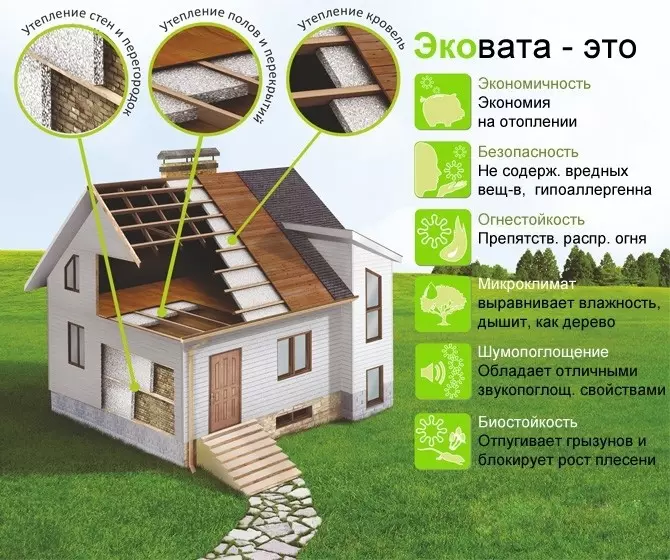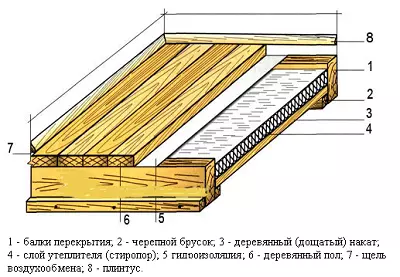Floor insulation is a necessary measure in order to make the house with warm, cozy, comfortable for living.

The main properties are eco.
The task of the heat insulation of the floor is not only not to skip the cold air into the house, but also not to produce warm. Heat losses through a radiated floor are up to 40% of all types of heat loss.
Universal material for insulation floors does not exist: each of them has both positive and negative characteristics.
Equata, or cellulose wool, is the material that has been distributed in the post-Soviet space from the 90s.
Structure:
- Secondary cellulose - 81%. Recycled waste paper, sawdust and other wood processing waste can be used as raw materials;
- Boric acid - 12%, antiseptic, ensures protection of material from destruction by bacteria and rodents;
- Bura - 7%, flame retardant, provides fireproof.
Dry Method of Styling Eco
This method of laying is the most acceptable for heat insulation.Main steps

Wood floor insulation diagram.
If there is already a concrete black floor in the house, its waterproofing is performed. The material can be rubberoid, polyethylene film. After that, lags are installed. The distance between them must be 60 cm, which corresponds to the sizes of the Eco Briquette. If there is no concrete floor and laugs are installed on the columns, it is lowered by boards or plywood to create an emotion box. In both cases, Ekwata is between lags, so there will be no load.
The insulation briquette is opened, the contents are poured into the container and dishes the mixer. The volume of material increases several times. Lags and base are wetted by water from the spray. This provides the adhesion with them to eco-art, which improves thermal insulation. The explosive mass falls asleep between lags, slightly higher than their level. Then the mass is compacted. If the thickness of the insulation is significant, it is necessary to cut it with layers, sealing each. It should not be very compacted, since in this case the thermal insulation will be ineffective.
Article on the topic: How to glue the plinth on the floor: Options
The surface of the eco-house should be moistened with a pulverizer. In a moistened eco-case, a structure is changing, a more dense surface layer is created. Eco-out practically does not contain volatile components, but to prevent dusting through the boarded floor, it is necessary to lay a vapor barrier film or geotextile. The recommended eco-layer thickness is at least 15 cm at air temperature in winter to -20 degrees. For regions with a lower layer thickness, it is necessary to increase by 1 cm for each degree.
The advantages of the method:
- work can be carried out at any temperatures;
- Work can be done yourself.
Disadvantages:
- work time-consuming;
- You need to work in the respirator.
Method of spraying or blowing
For insulation this method requires a team of specialists and expert equipment. The space between the lags is fascinated by an emotor in a dry state. The mass is injected under pressure until all the space fills. The material is strangled with excess, as it will subsequently fall. The method is effective when insulating old floors. It is enough to dismantle a few boards and insert the injection hose. The coating method is indispensable in cases where you need to make insulation of hard-to-reach places. For saving material use membrane packages. In the process of planking, they form a thermal closed circuit.
The advantages of the method:
- The highest quality of thermal insulation is ensured;
- The material is saved.
Disadvantages:
- work is expensive;
- It is impossible to do it yourself.
Equata has excellent characteristics. They are saved for the entire service life:
- Low thermal conductivity;
- excellent sound absorption;
- In contact with the metal, it does not cause it corrosion;
- Due to the low density, it does not create an additional load on the supporting structures;
- not destroyed moisture;
- The material "breathes" and thereby creates a healthy microclimate indoors.
Eco-friendly material, does not harm human health.
